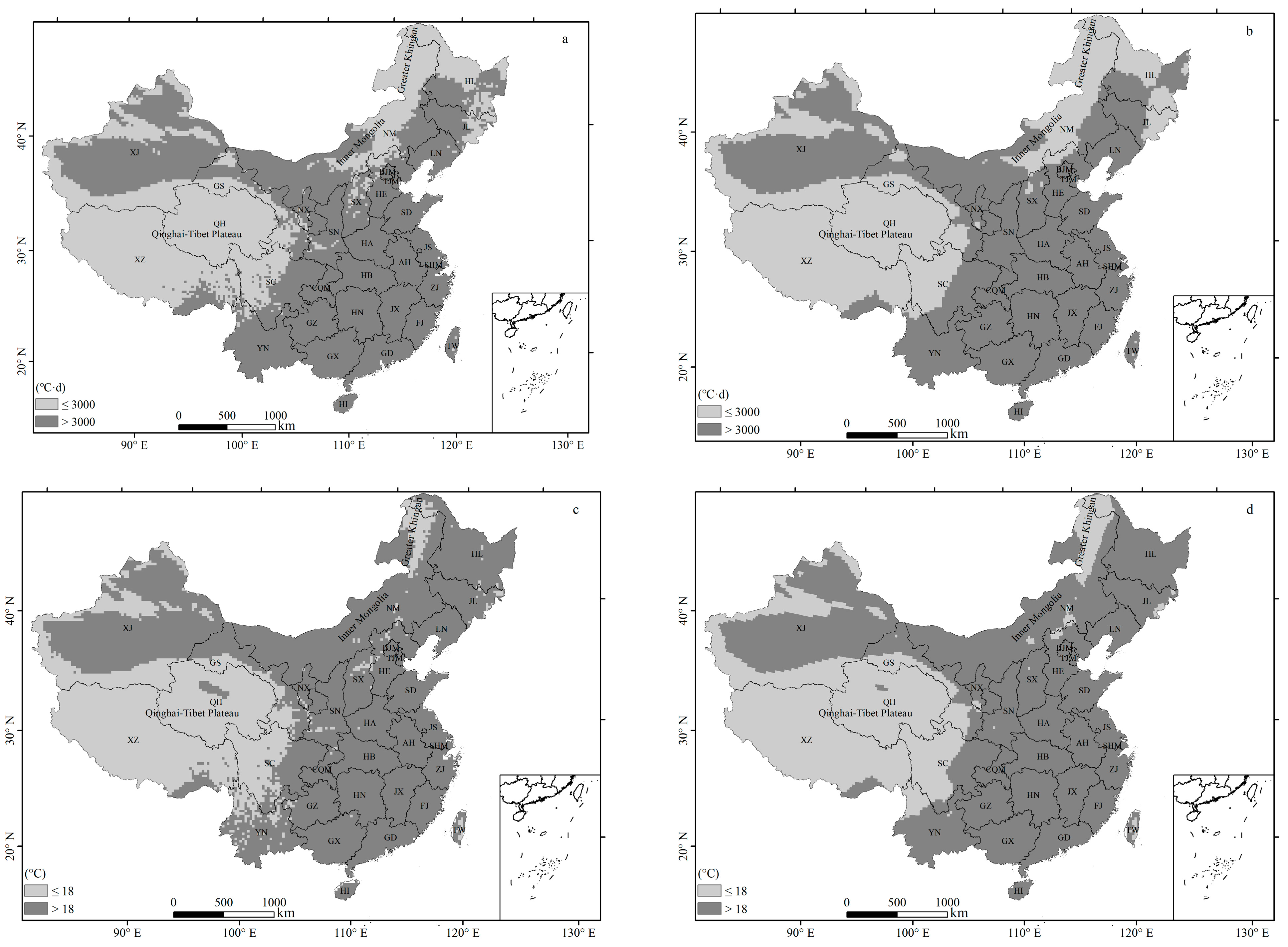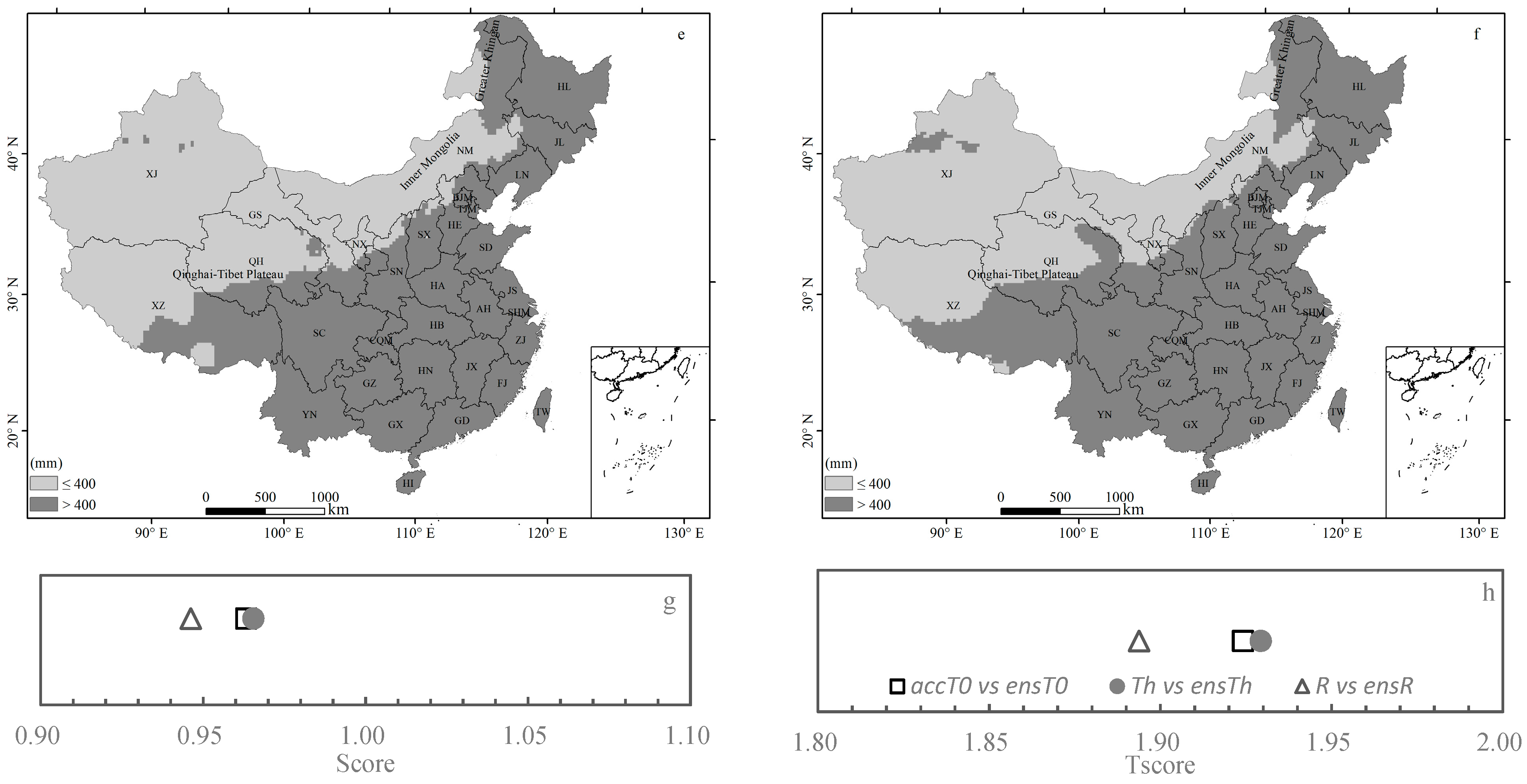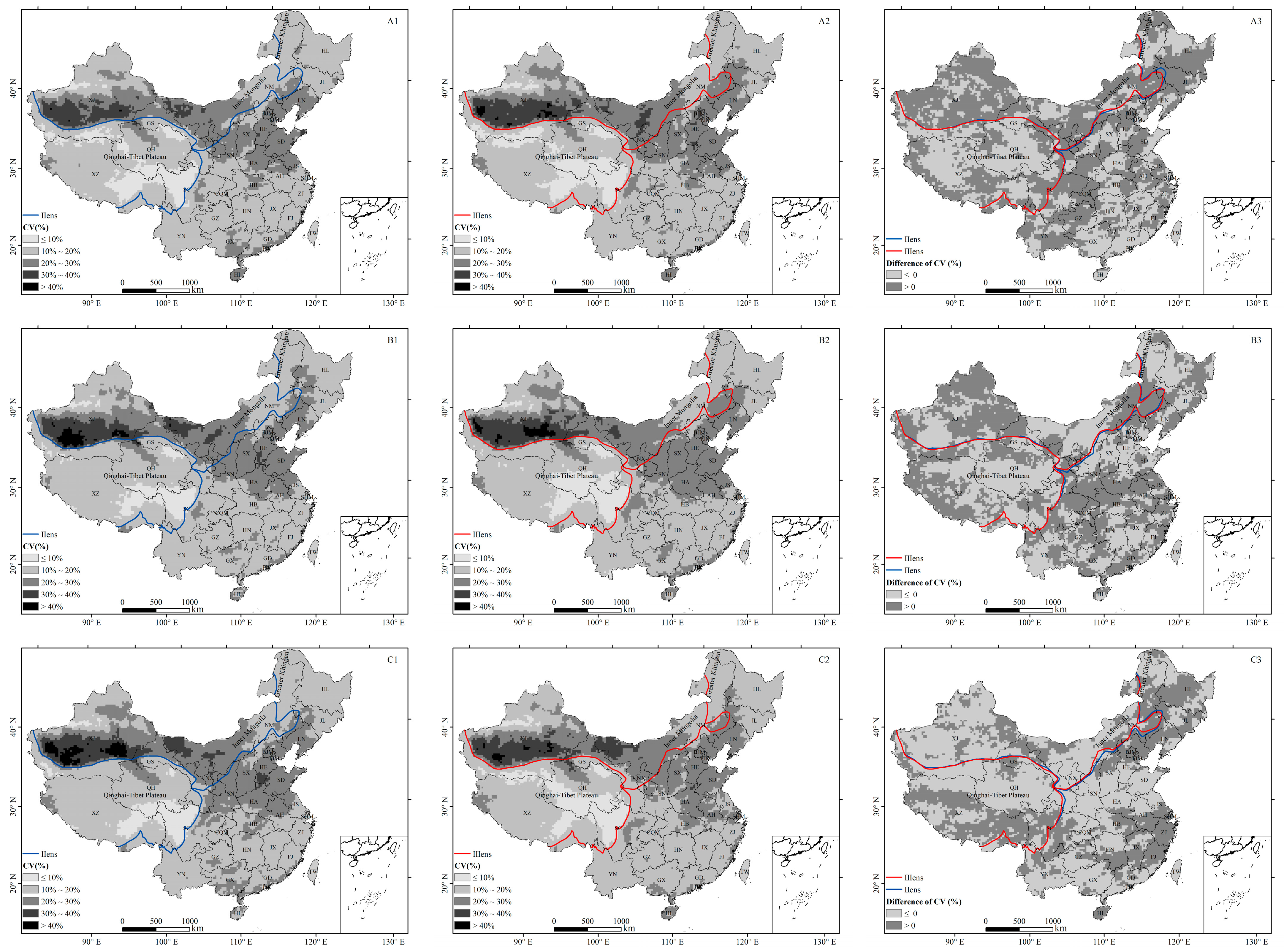The Effects of Global Warming on Agroclimatic Regions in China: Past and Future
Abstract
1. Introduction
2. Materials and Methods
2.1. Data
2.2. Simulation Data
2.3. Methodology
2.4. The Principle of Agroclimatic Regionalization
3. Results
3.1. Spatial Distribution of Climatic Indices
3.2. Evaluation of Simulation Results
3.3. Changes of the Agroclimatic Regions under the Historical Conditions
3.4. Changes in Agroclimatic Regions under the Future Climate Scenarios
4. Discussion
4.1. Indices and Standards of the Agroclimatic Regions
4.2. Distribution and Changes in the Agroclimatic Regions
4.3. Uncertainty
5. Conclusions
Author Contributions
Funding
Data Availability Statement
Conflicts of Interest
References
- Li, S. Agroclimatic regionalization of China. J. Nat. Resour. 1987, 2, 71–82. [Google Scholar]
- IPCC. Climate Change 2007: Synthesis Report; Cambridge University Press: Cambridge, MA, USA, 2007. [Google Scholar]
- Chu, Z.; Guo, J.; Zhao, J. Impacts of future climate change on agroclimatic resources in Northeast China. J. Geogr. Sci. 2017, 27, 1044–1058. [Google Scholar] [CrossRef]
- Piticar, A. Changes in agro-climatic indices related to temperature in Central Chile. Int. J. Biometeorol. 2019, 63, 499–510. [Google Scholar] [CrossRef] [PubMed]
- Trnka, M.; Eitzinger, J.; Semerádová, D.; Hlavinka, P.; Balek, J.; Dubrovský, M.; Kubu, G.; Štěpánek, P.; Thaler, S.; Možný, M.; et al. Expected changes in agroclimatic conditions in Central Europe. Clim. Chang. 2011, 108, 261–289. [Google Scholar] [CrossRef]
- Vasconcelos, R.d.L.; Rocha, L.A.G.; de Sousa, R.L.; Ferrari, J.M.d.S.; Lima, R.d.S.; Garcia, A.; Filho, L.R.A.G.; Gabriel, C.P.C. Agroclimatic Zoning for the Palm Euterpe edulis M. in So Paulo State, Brazil. J. Agric. Sci. 2019, 11, 217–230. [Google Scholar]
- Li, Q.; Pan, X. The impact of climate change on boundary shift of farming pasture ecotone in northern China. J. Arid Land Resour. Environ. 2012, 26, 1–6. [Google Scholar]
- Tian, Z.; Yang, X.; Sun, L.; Fischer, G.; Liang, Z.; Pan, J. Agroclimatic conditions in China under climate change scenarios projected from regional climate models. Int. J. Climatol. 2013, 34, 2988–3000. [Google Scholar] [CrossRef][Green Version]
- Liao, Y.M.; Zhai, P.M. Study on China’s Oning and Climate Atlas Scheme; China Meteorological Press: Beijing, China, 2014. [Google Scholar]
- Nabati, J.; Nezami, A.; Neamatollahi, E.; Akbari, M. GIS-based agro-ecological zoning for crop suitability using fuzzy inference system in semi-arid regions. Ecol. Indic. 2020, 117, 106646. [Google Scholar] [CrossRef]
- Wu, D.R.; Wang, P.J.; Huo, Z.G.; Yuan, X.K.; Jiang, H.F.; Yang, J.Y.; Ma, Y.P.; Guo, S.L. Climatic suitability regionalization of Camellia oleifera Abel. in China. Chin. J. Ecol. 2021, 40, 1313–1323. [Google Scholar]
- Zuo, C.; Song, F.; Shi, Y.; Luo, D. Climate regionalization of hybrid hazel planting in Xinjiang. Chin. J. Agrometeorol. 2020, 41, 146–155. [Google Scholar]
- Zhong, X.L.; Wang, D.L.; Zhao, P. Frost-driven agricultural climatic division of winter wheat in Huang-huai wheat produciton zones. Chin. J. Eco-Agric. 2008, 16, 11–15. [Google Scholar] [CrossRef]
- Graczyk, D.; Kundzewicz, Z.W. Changes of temperature-related agroclimatic indices in Poland. Theor. Appl. Climatol. 2016, 124, 401–410. [Google Scholar] [CrossRef]
- Chipanshi, A.; Berry, M.; Zhang, Y.; Qian, B.; Steier, G. Agroclimatic indices across the Canadian Prairies under a changing climate and their implications for agriculture. Int. J. Climatol. 2021, 42, 2351–2367. [Google Scholar] [CrossRef]
- Qian, B.; De Jong, R.; Gameda, S.; Huffman, T.; Neilsen, D.; Desjardins, R.; Wang, H.; McConkey, B. Impact of climate change scenarios on Canadian agroclimatic indices. Can. J. Soil Sci. 2013, 93, 243–259. [Google Scholar] [CrossRef]
- Linderholm, H.W.; Walther, A.; Chen, D. Twentieth-century trends in the thermal growing season in the Greater Baltic Area. Clim. Chang. 2008, 87, 405–419. [Google Scholar] [CrossRef]
- Liu, J.; Zhai, P. Changes in climate regionalization indices in China during 1961–2010. Adv. Atmos. Sci. 2014, 31, 11. [Google Scholar]
- Ding, Y. National assessment report of climate change (I): Climate change in China and its future trend. Adv. Clim. Chang. Res. 2006, 2, 3–8. [Google Scholar]
- Yang, X.; Liu, Z.; Chen, F. The possible effects of global warming on cropping systems in China VI.possible effects of future climate change on northern limits of cropping system in China. Sci. Agric. Sin. 2011, 44, 1562–1570. [Google Scholar]
- Shi, G.; Ye, P.; Yang, X. Spatio-Temporal Variation Analysis of the Biological Boundary Temperature Index Based on Accumulated Temperature: A Case Study of the Yangtze River Basin. Int. J. Geo-Inf. 2021, 10, 675. [Google Scholar] [CrossRef]
- Hutchinson, M.F. Interpolation of rainfall data with thin plate smoothing splines—Part I: Two dimensional smoothing of data with short range correlation. J. Geogr. Inf. Decis. Anal. 1998, 2, 139–151. [Google Scholar]
- Han, Z.; Xu, Y.; Wu, J.; Shi, Y. Evaluation on the simulated runoff in China and future change projection based on multiple regional climate models. Clim. Chang. Res. 2022, 18, 305–318. [Google Scholar]
- Tong, Y.; Han, Z.; Gao, X. Bias correction in climate extremes over China for high-resolution climate change RegCM4 simulations using QM and QDM methods. Clim. Environ. Res. 2022, 27, 383–396. [Google Scholar]
- IPCC. Climate Change 2013: The Physical Science Basis; Cambridge University Press: Cambridge, MA, USA, 2013. [Google Scholar]
- Chen, W. Theoretical calculation of the guarantee rate of agricultural climate indicators. Tibet J. Agric. Sci. 1979, 4, 21–28. [Google Scholar]
- Taylor, K.E. Summarizing multiple aspects of model performance in a single diagram. J. Geophys. Res. Atmos. 2001, 106, 7183–7192. [Google Scholar] [CrossRef]
- Qiu, B.; Lu, Q. A tentative regionalization of agroclimate of China. Acta Geogr. Sin. 1980, 35, 116–125. [Google Scholar]
- Qiu, B. A new discussion of the regionalization of agroclimate in China. Acta Geogr. Sin. 1986, 41, 202–209. [Google Scholar]
- Zhen, J.; Yin, Y.; Li, B. A new scheme for climate regionalization in China. Acta Geogr. Sin. 2010, 65, 3–12. [Google Scholar]
- Li, C.; Kang, S. Review of studies in climate change over the Tibetan Plateau. Acta Geogr. Sin. 2006, 61, 327–335. [Google Scholar]
- Bazi, Y.; Alajlan, N.; Melgani, F.; AlHichri, H.; Malek, S.; Yager, R.R. Differential evolution extreme learning machine for the classification of hyperspectral images. IEEE Geosci. Remote Sens. Lett. 2014, 11, 1066–1070. [Google Scholar] [CrossRef]
- Terehov, A.G.; Muratova, N.R.; Arkhipkin, O.P.; Spivak, L.F. Agroclimatic zoning of Kazakhstan territory using remote sensing data. In Proceedings of the IEEE International Geoscience & Remote Sensing Symposium, Honolulu, HI, USA, 24–28 July 2000; pp. 1975–1977. [Google Scholar]
- Zhao, J.; Hu, J.; Guo, X.; Wang, Q.; Wang, L.; Wang, M. Variation characteristics of thermal resources in Qinghai-Tibet Plateau in recent 50 years. Chin. J. Appl. Environ. Biol. 2022, 28, 822–828. [Google Scholar]
- Hijmans, R.J.; Cameron, S.E.; Parra, J.L.; Jones, P.G.; Jarvis, A. Very high resolution interpolated climate surfaces for global land areas. Int. J. Climatol. 2005, 25, 1965–1978. [Google Scholar] [CrossRef]
- Liu, Z.; McVicar, T.R.; Li, L. Interpolation for time series of meteorological variables using ANUSPLIN. J. Northwest A&F Univ. (Nat. Sci. Ed.) 2008, 36, 227–234. [Google Scholar]
- Tan, J.; Li, A.; Lei, G. Contrast on Anusplin and Cokriging meteorological spatial interpolation in southeastern margin of Qinghai-Xizang Plateau. Plateau Meteorol. 2016, 35, 875–886. [Google Scholar]
- Zhang, S.; Bai, M.H.; Qi, G.; Liang, J.; Zhao, T. Spatial simulation of active accumulative temperature ≥10 °C in Qinling-Daba Mountains based on Anusplin and multiple linear regression model. Res. Soil Water Conserv. 2022, 29, 184–196. [Google Scholar]
- Gillingham, K.; Nordhaus, W.D.; Anthoff, D.; Blanford, G.; Bosetti, V.; Christensen, P.; McJeon, H.; Reilly, J.; Sztorc, P. Modeling Uncertainty in Climate Change: A Multi-Model Comparison; MIT Joint Program on the Science and Policy of Global Change: Cambridge, MA, USA, 2015. [Google Scholar]
- Duan, Q.; Xia, J.; Miao, C.; Sun, Q. The uncertainty in climate change projections by global climate models. Chin. J. Nat. 2016, 38, 182–188. [Google Scholar]
- Tao, F.; Rötter, R.P.; Palosuo, T.; Díaz-Ambrona, C.G.H.; Schulman, A.H. Contribution of crop model structure, parameters and climate projections to uncertainty in climate change impact assessments. Glob. Chang. Biol. 2017, 24, 1291–1307. [Google Scholar] [CrossRef]







| Agroclimatic Region | Dominant Indices | Supplementary Indices | Reference Indices |
|---|---|---|---|
| Northwest Arid Region (NAR) | Accumulated frequency of 50% for 400 mm annual precipitation | Annual average days of average daily wind speed for above 5 m/s | Wind erosion and soil erosion at the boundary |
| Tibetan High Cold Region (THCR) | accT0 of 3000 °C·d, Th of 18 °C | Contour line (3000 m elevation) in the eastern part of the plateau | |
| Eastern Monsoon Region (EMR) | The western part of this region was adjacent to the NAR and the THCR from north to south. | ||
| Num | Station | Province | accT0/°C·d | Th/°C | ||||||||
|---|---|---|---|---|---|---|---|---|---|---|---|---|
| Period I | Period II | Period III | Period IV | Variation | Period I | Period II | Period III | Period IV | Variation | |||
| 1 | Yuzhong (Yz) | GS | 3055.1 | 3064.9 | 3135.5 | 3233.4 | 178.3 | 18.8 | 18.9 | 19.3 | 19.5 | 0.7 |
| 2 | Anding (An) | GS | 2972.1 | 3035.0 | 3173.3 | 3307.4 | 335.2 | 18.3 | 18.6 | 19.3 | 19.7 | 1.4 |
| 3 | Huajialing (Hj) | GS | 2132.1 | 2174.3 | 2237.8 | 2323.6 | 191.5 | 14.6 | 14.8 | 15.1 | 15.4 | 0.8 |
| 4 | Xiji (Xj) | NX | 2730.7 | 2771.3 | 2851.2 | 2959.9 | 229.2 | 17.7 | 18.0 | 18.3 | 18.7 | 1 |
| 5 | Longde (Ld) | NX | 2612.2 | 2643.9 | 2710.1 | 2822.1 | 228.8 | 16.8 | 17.0 | 17.3 | 17.7 | 0.9 |
| R/mm | α | |||||||||||
| Period I | Period II | Period III | Period IV | Variation | Period I | Period II | Period III | Period IV | Variation | |||
| 6 | Tongyu (Ty) | JL | 406.0 | 391.4 | 370.7 | 364.3 | −41.7 | 0.06 | −0.09 | −0.29 | −0.38 | −0.45 |
| 7 | Bayaertu (By) | NM | 430.4 | 437.8 | 411.2 | 401.0 | −29.4 | 0.31 | 0.31 | 0.08 | 0.01 | −0.30 |
| 8 | Duolun (Dl) | NM | 370.1 | 386.5 | 377.9 | 383.7 | 13.6 | −0.43 | −0.19 | −0.33 | −0.25 | 0.17 |
| 9 | Zhangjiakou (Zj) | HB | 398.5 | 403.6 | 388.7 | 411.1 | 12.6 | −0.02 | 0.04 | −0.13 | 0.13 | 0.15 |
| 10 | Huailai (Hl) | HB | 383.1 | 372.4 | 367.9 | 397.1 | 14.0 | −0.20 | −0.37 | −0.44 | −0.03 | 0.17 |
Disclaimer/Publisher’s Note: The statements, opinions and data contained in all publications are solely those of the individual author(s) and contributor(s) and not of MDPI and/or the editor(s). MDPI and/or the editor(s) disclaim responsibility for any injury to people or property resulting from any ideas, methods, instructions or products referred to in the content. |
© 2024 by the authors. Licensee MDPI, Basel, Switzerland. This article is an open access article distributed under the terms and conditions of the Creative Commons Attribution (CC BY) license (https://creativecommons.org/licenses/by/4.0/).
Share and Cite
Gong, L.; Liao, Y.; Han, Z.; Jiang, L.; Liu, D.; Li, X. The Effects of Global Warming on Agroclimatic Regions in China: Past and Future. Agronomy 2024, 14, 293. https://doi.org/10.3390/agronomy14020293
Gong L, Liao Y, Han Z, Jiang L, Liu D, Li X. The Effects of Global Warming on Agroclimatic Regions in China: Past and Future. Agronomy. 2024; 14(2):293. https://doi.org/10.3390/agronomy14020293
Chicago/Turabian StyleGong, Lijuan, Yaoming Liao, Zhenyu Han, Lanqi Jiang, Dan Liu, and Xiufen Li. 2024. "The Effects of Global Warming on Agroclimatic Regions in China: Past and Future" Agronomy 14, no. 2: 293. https://doi.org/10.3390/agronomy14020293
APA StyleGong, L., Liao, Y., Han, Z., Jiang, L., Liu, D., & Li, X. (2024). The Effects of Global Warming on Agroclimatic Regions in China: Past and Future. Agronomy, 14(2), 293. https://doi.org/10.3390/agronomy14020293





